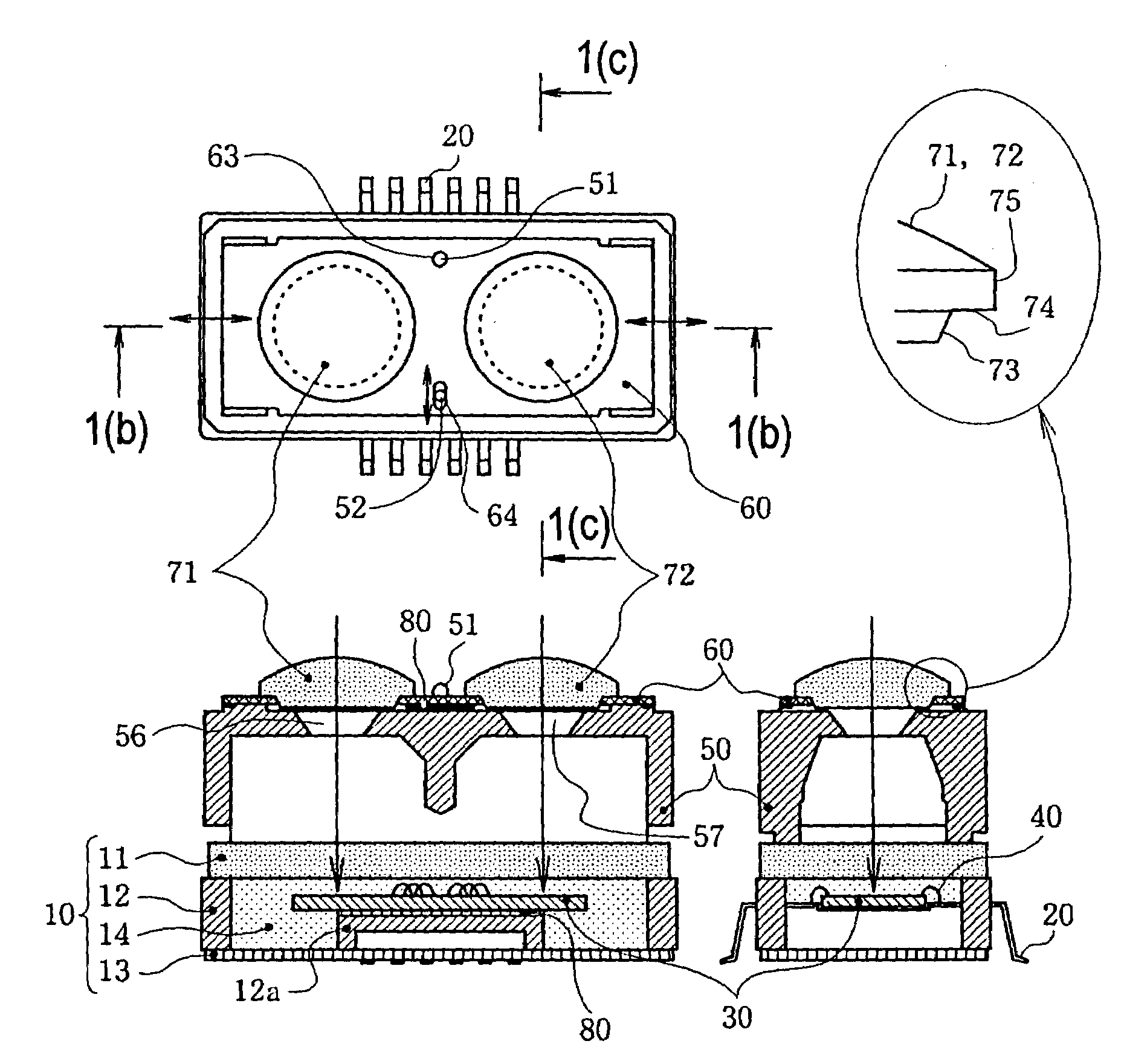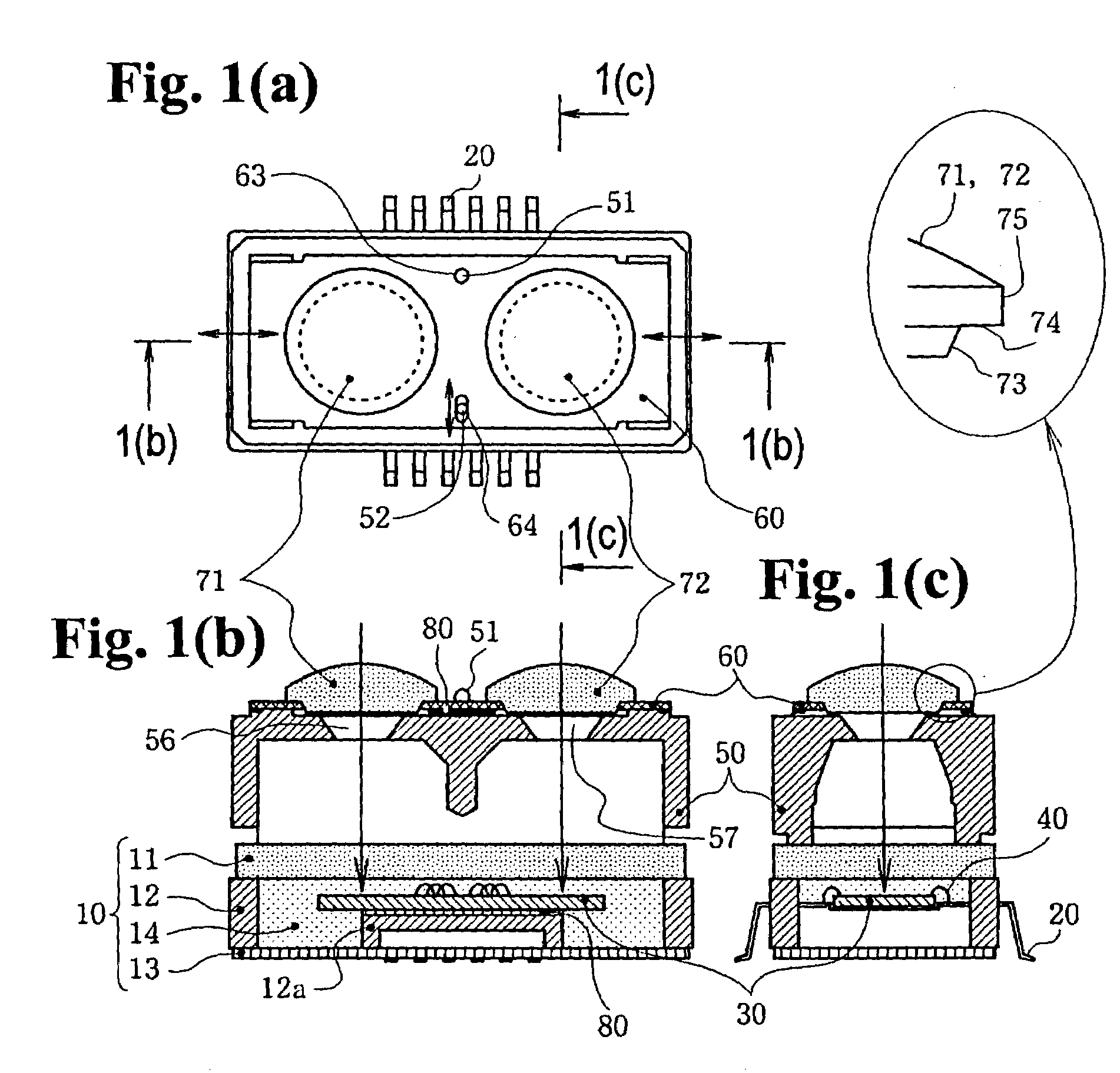Range finder
a range finder and optical range technology, applied in the field of optical range finders or distance measuring devices, can solve the problems of measurement distance errors, affecting the distance b of the detecting device of the semiconductor chip, and the conventional techniques described above have various problems, so as to reduce the influence of thermal expansion and contraction of the optical casing, reduce the influence and reduce the effect of thermal expansion and contraction
- Summary
- Abstract
- Description
- Claims
- Application Information
AI Technical Summary
Benefits of technology
Problems solved by technology
Method used
Image
Examples
first embodiment
[0096]The invention has been described above with reference to the The invention is not limited to the specific embodiment, and any changes and modifications are possible within the scope of the invention.
[0097]A second embodiment of the invention will be described next with reference to FIGS. 4(a) through 6. FIGS. 4(a) to 4(c) are views showing a range finder according to the second embodiment of the present invention, wherein FIG. 4(a) is a plan view thereof, FIG. 4(b) is a cross sectional view taken along line 4(b)—4(b) in FIG. 4(a), and FIG. 4(c) is a cross sectional view taken along line 4(c)—4(c) in FIG. 4(a). FIGS. 5(a) to 5(d) are views showing components of the range finder shown in FIGS. 4(a) to 4(c), wherein FIG. 5(a) is a plan view of a lens holder, FIG. 5(b) is a front view of a lens, FIG. 5(c) is a bottom view of the lens, and FIG. 5(d) is a side view of the lens. FIG. 6 is a plan view of the range finder for explaining an adhesion therein and thermal expansion and co...
second embodiment
[0110]In the second embodiment, the circular reference holes 105 and long absorbing holes 106 are arranged on the extension of the line connecting the centers of the first and second lens holes 101 and 102 (line connecting the centers of the circular reference holes 105), and the long absorbing holes 106 extend along the extension of the line. When the lenses 111 and 112 rotate around the reference bosses 116 in the circular reference holes 105 due to the temperature change, the absorbing bosses 117 in the long absorbing holes 106 restrict the lenses 111 and 112. As a result, the displacement of the optical axes of the lenses 111 and 112 due to temperature change of the adhesive layers 80 is limited substantially to the line connecting the centers of the first and second lens holes 101 and 102 by the long absorbing holes 116 and the absorbing bosses 117. A change in the distance between the optical axes of the first and second lenses 111 and 112 is very small as compared with the le...
third embodiment
[0115]A third embodiment of the invention will be described with reference to FIGS. 7(a) through 9. FIGS. 7(a) to 7(c) are views showing a range finder according to the present invention, wherein FIG. 7(a) is a plan view thereof, FIG. 7(b) is a cross sectional view taken along line 7(b)—7(b) in FIG. 7(a), and FIG. 7(c) is a right side view of the range finder. FIGS. 8(a) and 8(b) are views showing components of the range finder shown in FIGS. 7(a) to 7(c), wherein FIG. 8(a) is a plan view of an optical casing, and FIG. 8(b) is a plan view of a lens holder. FIG. 9 is a diagram for explaining the principle of canceling the thermal expansion and contraction.
[0116]As shown in FIGS. 7(a) through 7(c), in the third embodiment, a range finder 3 includes the package 10, the leads 20, the semiconductor chip 30, the bonding wires 40, an optical casing 120, a lens holder 130, a pair of lenses 110, and the adhesive layers 80. The lenses 110 are two discrete lenses, namely a first lens 111 on th...
PUM
 Login to View More
Login to View More Abstract
Description
Claims
Application Information
 Login to View More
Login to View More - R&D
- Intellectual Property
- Life Sciences
- Materials
- Tech Scout
- Unparalleled Data Quality
- Higher Quality Content
- 60% Fewer Hallucinations
Browse by: Latest US Patents, China's latest patents, Technical Efficacy Thesaurus, Application Domain, Technology Topic, Popular Technical Reports.
© 2025 PatSnap. All rights reserved.Legal|Privacy policy|Modern Slavery Act Transparency Statement|Sitemap|About US| Contact US: help@patsnap.com



